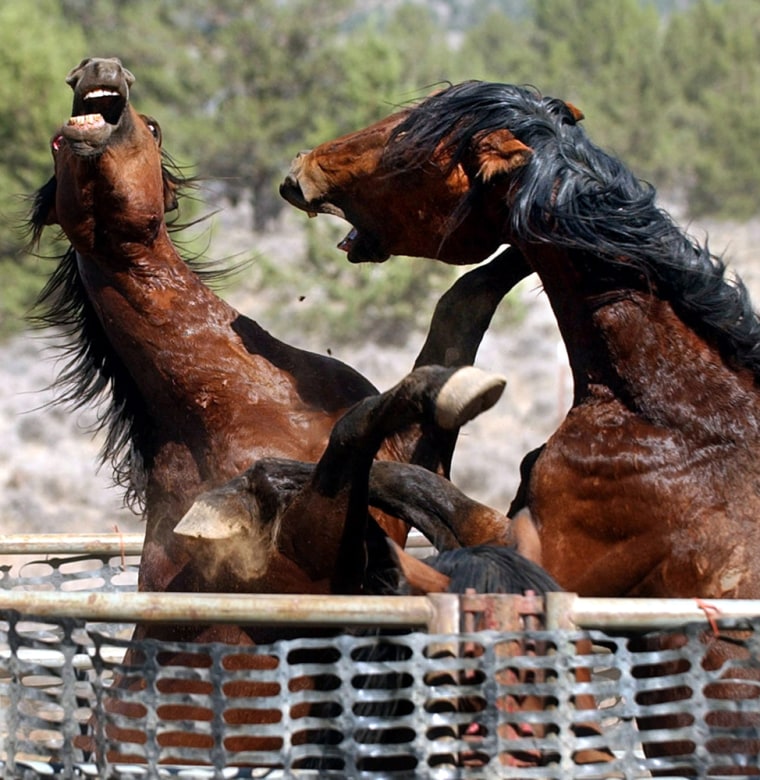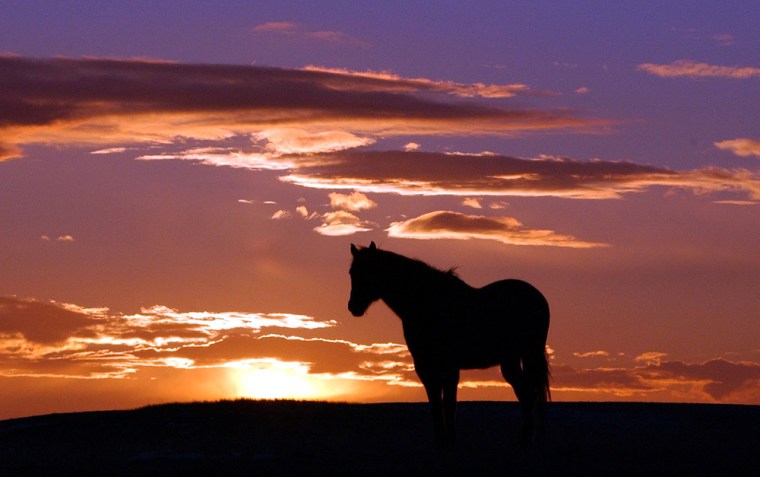They are revered as majestic, galloping icons of the American West — or reviled as starving, disfigured varmints that rob ranchers of their livelihood.
Wild horses and burros are stirring emotional debate from Western rangelands to the halls of Congress after dozens of horses were slaughtered legally in April. Protections for the mustangs that might have prevented the slaughter were repealed in December, but now some in Congress are pushing a measure to reinstate those protections.
The bill has passed the House and is headed to the Senate.
The free-roaming palomino is “a beloved literary figure, a character in a movie or television show, a symbol of adventure, a friend of the cowboy, and an important part of our history,” Rep. Jim Moran, D-Va., said during House debate on the bill.
Opponents, mostly Western Republicans, say the measure is unnecessary because the Bureau of Land Management has taken steps to make sure no more of the nation’s 31,000 wild horses and burros are sent to slaughter. They say support for the bill comes primarily from Eastern city slickers who don’t understand the ways of the West.
A real turf war
The debate is the latest in a decades-old turf battle that’s literally about the turf — that is, the grass, which grows thick in wet years and disappears in drought.
Wild mustangs and burros, which roam free on federal lands in 10 Western states, eat that grass for sustenance. But so do huge herds of livestock. The BLM believes only 28,000 wild horses and burros can survive on the range without interfering with livestock grazing and other land uses.

To reach that target, the BLM has authority to capture excess wild horses and burros, offer them for private adoption, and eventually sell them to private buyers. Under the old law, buyers were required to feed and house the animals for a year before receiving title — a delay intended to weed out those looking to resell the horses.
But under the more recent law, passed in December at the urging of Sen. Conrad Burns, R-Mont., the waiting period is removed. Without the waiting period, 41 horses recently ended up at a slaughterhouse in Illinois: An Oklahoma buyer who said he wanted six horses for a church camp sold them for slaughter, and a South Dakota tribe traded 35 horses to a third party who did the same.
This sort of slaughter is the target of the bill now moving through Congress. Called the Rahall-Whitfield amendment, the bill would reimpose the yearlong waiting period.
Supporters say the wild horses and burros are not starving. They say the current population can be accommodated on Western lands, and they accuse ranchers of being unwilling to compromise.
“They are grazing over eight or nine million cows on this land, and we are talking about 31,000 wild mustangs and burros,” said Rep. Ed Whitfield, R-Ky., who is co-sponsoring the protection measure with Rep. Nick Rahall, D-W.Va. “We all like a good steak. ... But we also have a responsibility to protect wild mustangs and burros who are native to this country, who have been protected in this country.”
Bottleneck due to bill?
Opponents of the bill call it misguided. The BLM has thousands of horses in holding pens awaiting adoption. Opponents say the agency needs to be able to sell them more easily to clear space for more horses — horses that must be captured to ease overpopulation on the open range.
“Our wild horses are already competing for scarce sources of food and water on rangelands in arid states like Nevada, causing many of them to waste into skin and bones,” said Republican Rep. Jon Porter of Nevada, home to about half of the nation’s 31,760 wild horses and burros.
Said Rep. Jim Gibbons, R-Nev.: “In Nevada, horses do not always look beautiful like the horse that we see in ‘Black Beauty.’ Sometimes they are misshapen. Sometimes they are deformed.”
Also, opponents of the Rahall-Whitfield amendment say, there’s no need to change the law to prevent further slaughter. Since the April incident, the BLM has required buyers to sign a statement saying they do not intend to resell the horses for slaughter. Buyers could face criminal prosecution if they do.
Horse protection groups say that does no good because there’s no way to prove someone’s intention. They also call ranchers’ claims that wild horses and burros are starving disingenuous.
“There is not an overpopulation problem. There’s a serious question as to whether the population is actually dwindling beyond repair,” said Nancy Perry, vice president of the Humane Society of the United States.
